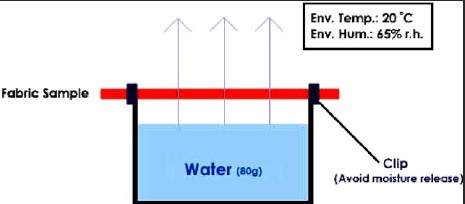The Water Vapor Permeance is often simply call the permeance, and the water vapor permeability is often simply called the permeability. The Water Vapor Transmission (WVT), permeance, and permeability are very closely related in that one is calculated from the other. First the WVT is determined. Then the permeance is calculated by dividing the WVT by the vapor pressure across the material under test. The permeability is calculated by multiplying the permeance by the thickness of the material.

The fundamentals of the measurement of water vapor transmission in the laboratory are simple. WVT is determined by sealing a free film of the test material to the top of a container that is filled with water (left) or desiccant (right). If the container is filled with water, the method is called the wet cup method or the water method. If the container is filled with desiccant, the method is called the dry cup method or the desiccant method. Essentially, the test determines how much vapor is lost through the film in the wet cup method or how much vapor the desiccant attracts or draws through the film for the dry cup method.
water vapor transmission permeabilityThe weight data is plotted versus time. The system may at first gain or lose weight more quickly, and then settle into a constant or steady-state rate of weight change after a couple of days, or longer, depending on the type of material being tested.
If the cup is filled with water, the dish loses water over the course of the test so the plot points downward. If the cup contains desiccant, the dish gains water (weight) over the course of the test, so the plot points upward. In either case, the slope of the plot is the rate of weight change and its units are mass per time. For example, the units might be grams per hour or nanograms per 24 hours.